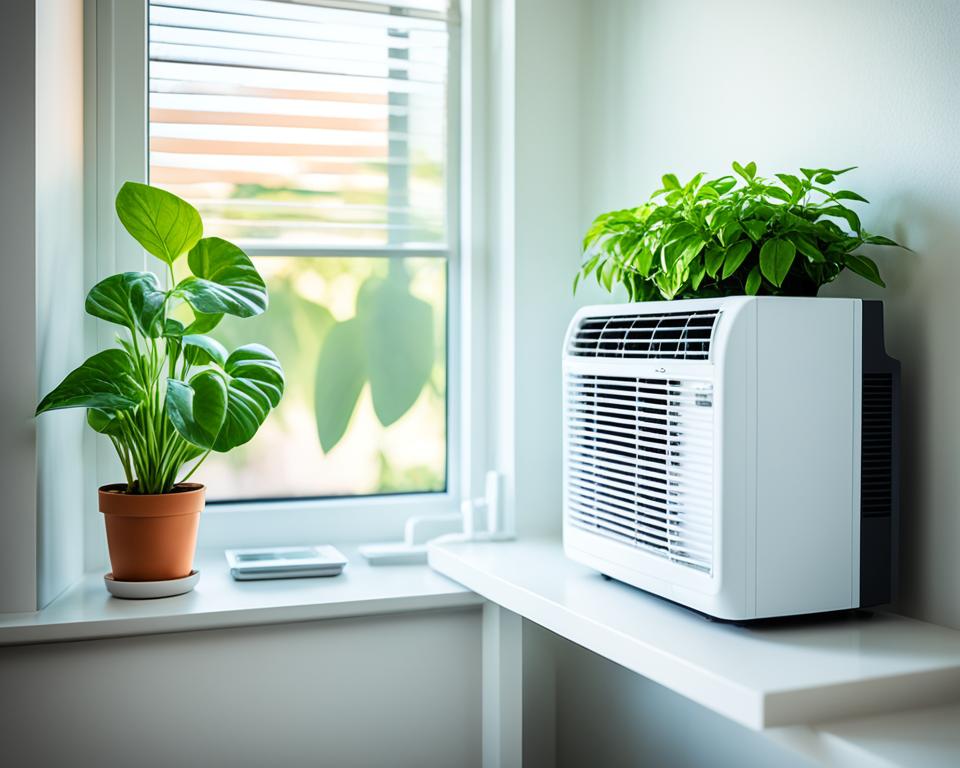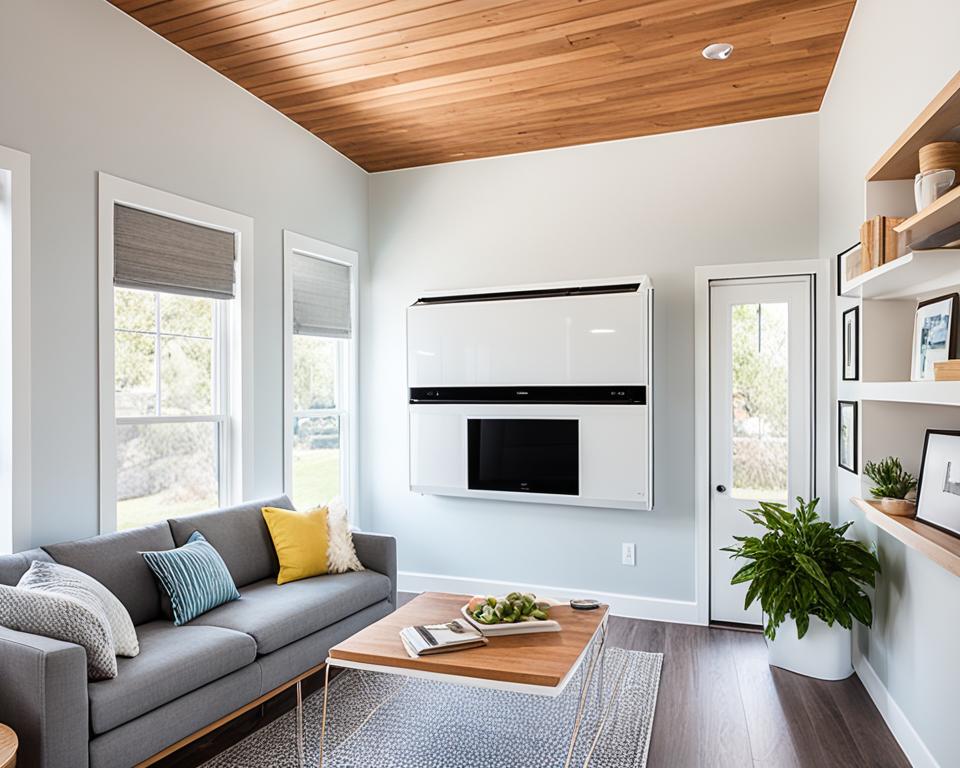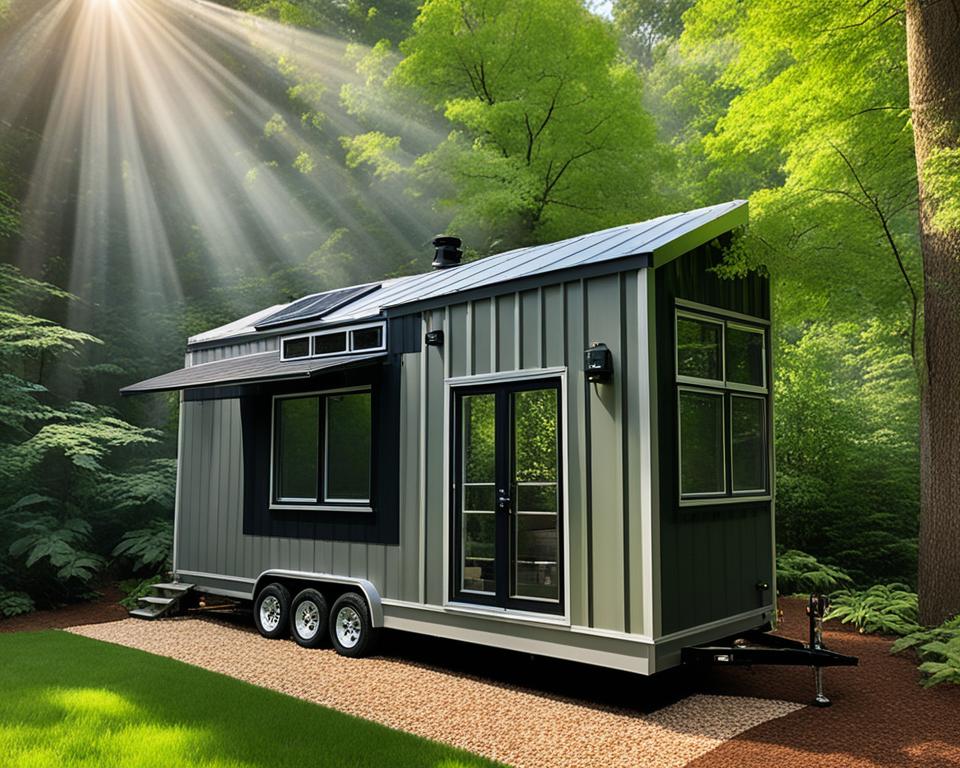A staggering 68% of tiny house dwellers own their homes outright, unlike the mere 29.3% of conventional homeowners. This shift towards tiny living isn’t just about financial savings. It encompasses making intelligent, sustainable cooling decisions. Because of the limited space, choosing the right air conditioning unit is critical. It ensures comfort without compromising minimalist values, which are central to the lifestyle.
This guide delves into the intricacies of maintaining a cool, pleasant micro-home. We cover everything from energy-saving air conditioners designed for small areas to installation and upkeep strategies. This information is vital for both experienced tiny homeowners and those contemplating a simpler lifestyle. Our goal is to help you keep your tiny home a cool haven, regardless of the external temperatures.
This is your ultimate guide to managing your tiny home’s climate. We’re about to explore air conditioning solutions that balance compactness, efficiency, and a light environmental impact. Join us in navigating the options to find the perfect fit for your tiny abode.
Understanding the Unique Cooling Needs of Tiny Homes
We’re on a mission to find cooling solutions that fit the minimalist lifestyle of tiny homes. Searching for the right small space cooling solution requires deep knowledge of these unique environments. The American Tiny House Association emphasizes the special need for tiny home HVAC options. This points to the distinctive challenges tiny homes introduce.
The Challenges of Small Space Cooling
Tiny homes, with their limited space, demand careful selection of HVAC systems. It’s a balance between the small size and the need for effective air flow and temperature management. Too big units can cause humidity and energy waste. Yet, too small ones may not cool effectively, stressing the importance of precise tiny home HVAC options.
Benefits of Choosing the Right Air Conditioner
Energy-Star ratings are crucial for picking air conditioners for tiny homes. Selecting a suitable HVAC system allows homeowners to enjoy comfort during hot days without high energy costs. It transcends convenience, aligning with the values of sustainable tiny home living. Choosing the right air conditioner brings eco-friendliness, efficiency, and comfort into harmony.
Top Considerations When Selecting a Tiny House Air Conditioner
In optimizing tiny house cooling, some factors are crucial. The size is pivotal, affecting comfort and efficiency in small spaces. An energy-efficient mini air conditioner becomes the top choice. It helps maintain a small carbon footprint while keeping living spaces comfortable.
Finding an efficient unit involves more than high-energy ratings. The compact AC unit must fit your space perfectly. Too large, and you waste energy; too small, and it struggles to provide adequate cooling. Noise level is key in tiny houses, where space is limited. A quieter system ensures a peaceful home.
Energy Efficiency: Choosing an air conditioner that excels in energy efficiency is crucial. An energy-efficient mini air conditioner cuts utility costs and supports an eco-friendly lifestyle. This aligns with the tiny house movement’s values. Also, consider installation ease, which can save time and money.
Visual appeal and the unit’s size matter too. A compact AC unit should complement your space’s design without overpowering it. Thus, selecting an air conditioner that looks good and performs well is essential for balancing aesthetics with energy savings.
When choosing an air conditioner, weigh these points for practicality and efficiency:
- Size relative to space to be cooled
- Energy efficiency ratings and eco-impact
- Noise level for a peaceful living environment
- Ease and requirements of installation
- Compatibility with the visual and spatial design of your tiny home
Decisions must consider these factors to keep tiny houses comfortable and efficient. By balancing these aspects, the right energy-efficient mini air conditioner can meet our small living spaces’ unique needs.
Compact AC Unit Models Perfect for Tiny Living
Talking about tiny living often means finding ways to make every inch count. It’s crucial that each appliance, especially air conditioners, fits well without taking up too much space. We’ll explore the top compact AC units that work best for small living spaces. These options ensure comfort, convenience, and a seamless fit into your tiny home lifestyle.
Window-Mounted Air Conditioners
Window-mounted air conditioners are great for tiny homes because of their affordability and easy setup. Designed to fit within your window frame, they save precious floor space in your small dwelling. They might not win any design awards and can reduce natural light, but they are cost-effective. For those on a tight budget, these units are an efficient way to stay cool.
Split System Air Conditioners
If you prefer a sleek look and quiet operation, consider split system air conditioners. They comprise an outside compressor and internal air outlets, taking up minimal wall space. While they might require a bigger upfront investment, their benefits include energy savings and quiet performance. They’re perfect for maintaining the peaceful ambiance of a tiny home.
Here are some of the leading window-mounted and split system air conditioners suitable for tiny houses:
| Model Type | Brand and Model | Key Features | Estimated Price |
|---|---|---|---|
| Window-Mounted | Frigidaire FFRA0511R1 | Compact size, Quick cooling, Mechanical controls | $160 |
| Window-Mounted | LG LW8016ER | Energy Star certified, Remote control, Multiple fan speeds | $279 |
| Split System | Pioneer WYS012-17 | High efficiency, Ultra-silent, Inverter technology | $738 |
| Split System | Mitsubishi MSZ-GL12NA | Advanced filtration, Low ambient operation, Energy-efficient | $1,489 |
Portable Air Conditioning for Tiny Homes: Pros and Cons

For compact living spaces, portable air conditioners are a popular choice. They are easy to install and move around. Many prefer them for their simplicity, especially when standard HVAC installations are impractical or too expensive.
However, portable air conditioning for tiny homes may not be as efficient as fixed systems. Their design for mobility can lead to poor insulation and sealing. This might result in higher energy expenses.
- Portability allows for easy repositioning and targeted cooling.
- No installation costs or permanent modifications required.
- Ideal for renters or homeowners who prefer a non-permanent solution.
Space is a vital concern in tiny homes, which strive to use every square inch efficiently. Portable units occupy precious floor space. This can disrupt the layout and usability of the home.
| Pros of Portable Air Conditioning | Cons of Portable Air Conditioning |
|---|---|
| Flexibility in placement and movement | Can take up valuable floor space |
| No need for permanent installation | Less energy efficient than other types |
| Can be stored away when not in use | May be noisier than built-in systems |
Our advice is clear. Portable air conditioning suits those who need a mobile or seasonal cooling option. It works as a stopgap or for homes where regular air conditioning systems don’t fit well.
Energy-Efficient Mini Air Conditioner: Saving on Utility Costs
We’re huge supporters of cost-effective, green living, and it’s crucial to highlight the substantial long-term cost benefits of using an energy-efficient mini air conditioner. Through the lens of small space cooling solutions, it’s not only the immediate comfort from the heat but also the ongoing energy bill reduction. This is the rationale behind the economics of selecting an efficient model:
- A lower energy bill each month means more money in your pocket
- Incentives or rebates often available for energy-saving appliances
- Longevity of efficient units means fewer replacements
Energy efficiency transcends individual financial benefits—it embodies our shared duty towards the planet. Opting for an energy-efficient mini air conditioner cuts down on power plant emissions, shrinking your ecological footprint.
| Model | Energy Efficiency Ratio (EER) | Estimated Annual Energy Use | Smart Features |
|---|---|---|---|
| EcoCool Pro | 12.5 | 450 kWh | Yes |
| GreenChill Max | 11.0 | 550 kWh | No |
| NaturaAir Mini | 10.7 | 500 kWh | Yes |
| PureCool Deluxe | 12.0 | 480 kWh | Yes |
What enables these units to excel in tiny living spaces? Their design focuses on practicality and minimalist beauty, ensuring they enhance small spaces. These models embody the tiny house movement’s values, offering effective cooling without sacrificing space or comfort.
Choosing an energy-efficient mini air conditioner doesn’t just mean cooler air; it signifies a commitment to sustainable living and reduced utility expenses. It’s a wise choice for your finances and the earth, promoting a sense of well-being for everyone involved.
Installation Tips for Small Space Cooling Solutions
Selecting the ideal HVAC solution for a tiny home is a critical step. Yet, the key to efficiency and long-term performance lies in the installation. The decision to install the system yourself or to engage professional services is influenced by your technical skill level and the complexity of the chosen system.
DIY Installation vs. Professional Help
A do-it-yourself approach can be fulfilling for the hands-on homeowner. User-friendly installation kits and instructions are often included with tiny home HVAC options. However, it’s vital to know when a project exceeds your skills. Especially for complex setups like split units, professional handling is essential for managing refrigerants and electrical components correctly. Here are essential installation tips:
- Thoroughly review all manufacturer guidelines before beginning.
- Ensure you have the necessary tools and safety equipment on hand.
- Remember, precision is key – measure twice, install once!
- Seek out video tutorials or community forums for additional support.
If in doubt, choose professional installation to protect your investment. Only experts can guarantee the system’s efficiency and compliance with warranty requirements.
Ensuring Proper Ventilation
Proper ventilation is crucial for any HVAC system, especially in small spaces. A system installed by professionals improves air quality and prevents moisture issues. Consider the following essential steps:
- Position the unit to allow for unobstructed air flow.
- Check for any air leaks and insulate your space appropriately.
- Regular maintenance checks can prevent ventilation issues.
Achieving a balance between insulation and ventilation is vital. Good ventilation enhances comfort and the health of your tiny home environment. It’s crucial for overall well-being.
In conclusion, choosing between DIY and professional HVAC installation depends on personal skills and system complexity. Always consider the critical role of proper ventilation. The table below outlines key considerations for your installation journey.
| Installation Aspect | DIY Consideration | Professional Recommendation |
|---|---|---|
| Tools and Equipment | Basic handyman tools | Specialized HVAC equipment |
| Safety Procedures | Basic precautions | Advanced safety protocols |
| Technical Expertise | Some proficiency required | Comprehensive expertise |
| Time Commitment | Varies based on skill | Typically faster completion |
| Warranty Assurance | May void warranty | Usually warranty protected |
How to Maintain Your Tiny Home HVAC Options for Longevity
Embracing the tiny home way of life demands understanding the upkeep of tiny home HVAC systems for enduring efficiency and comfort. Regular maintenance is essential as it directly influences your system’s performance and durability. In this context, we shall explore key maintenance practices. These practices are vital for keeping your system operational over the years.
- Regular Filter Replacement: In any home, changing the HVAC system’s air filters regularly maintains air quality and prevents your air conditioner from overworking. It’s recommended to replace filters every 1-3 months, considering your usage and environmental factors.
- Cleaning Components: Cleaning the condenser and evaporator coils occasionally is critical for optimal efficiency. Accumulation of dust and debris compromises airflow and heat absorption capabilities, undermining the system’s efficiency.
- Checking Refrigerant Levels: Adequate refrigerant levels are paramount. Low refrigerant can reduce cooling effectiveness and potentially harm the compressor. Be vigilant for refrigerant leaks and get professional assistance immediately if detected.
- Ensuring Proper Ventilation: Adequate ventilation is crucial to prevent moisture and consequent mold or mildew issues, promoting clean and healthy air circulation.
- Scheduling Professional Maintenance: Annual inspections by professionals are advisable. They conduct thorough examinations, including checks on electric controls and thermostat operations, ensuring everything is in order.
Caring for your system also involves recognizing the right time to seek expert help. Warning signs like unusual noises, increased electricity bills, or failure to maintain desired temperatures call for professional intervention. Addressing these signals early can save you from costlier repairs later.
By adopting these maintenance strategies, you not only prolong the life of your tiny home HVAC system. You also guarantee a comfy and eco-friendly living space for the foreseeable future.
Advanced Features to Look for in a Tiny House Air Conditioner

Exploring the realm of advanced tiny house air conditioners opens up new horizons. Today’s air conditioners do more than just cool; they enhance your tiny home’s livability. We’re about to delve into the latest and greatest smart compact AC units.
Smart Technology Integration
Smart technology has revolutionized tiny house living. Remote climate control is now possible via smartphones or tablets. This is key in small spaces, ensuring both comfort and energy efficiency. With features like Wi-Fi and voice commands through Alexa or Google Home, controlling your AC has never been easier.
Programmable Settings
Optimizing your smart compact AC unit is easy with programmable settings. They let you tailor cooling schedules and eco-modes to reduce energy use. A steady temperature is maintained, vital for tiny homes. This customization keeps your space comfortable and energy-efficient.
| Feature | Description | Benefit |
|---|---|---|
| Wi-Fi Enabled Control | Operate your AC from anywhere using your mobile device. | Convenience and energy savings through precise control. |
| Voice Command Integration | Use voice commands to adjust settings without lifting a finger. | Accessibility and ease-of-use; perfect for multitasking. |
| Eco-Mode | A setting that optimizes performance for energy efficiency. | Reduces carbon footprint and utility bills. |
| Sleep Functionality | Lessens operation noise and adjusts temperature during sleep hours. | Enhances sleep quality while saving energy at night. |
| Remote Diagnostics | Monitors system performance and provides maintenance alerts. | Prevents potential issues, ensuring longevity and reliability. |
Advances in advanced tiny house air conditioners are more than mere cooling solutions. They reflect the ideals of efficiency, simplicity, and forward-thinking that define tiny living. As such, when scouting for a new AC, prioritize these innovative features that enhance both comfort and modernity.
Conducting Thorough Research: Customer Reviews and Ratings
In our quest for the ultimate cooling system for tiny houses, it’s crucial to consider firsthand experiences. We delve into customer reviews and energy-efficient air conditioner ratings for insight. These provide invaluable confirmations on whether a unit meets our efficiency, size, and performance criteria.
What Other Tiny Home Owners Are Saying
The community’s input is vital. Reviews allow us to see tiny home air conditioners through the eyes of owners. We learn how these units perform in compact spaces, considering noise levels, installation, and maintenance. Such feedback hones in on products worth considering for similar setups.
Interpreting Energy Ratings and Consumer Feedback
Understanding energy ratings is critical. They show an air conditioner’s energy use and potential savings. Reviewing consumer feedback helps us spot patterns and issues. We meticulously analyze these insights to recommend options that meet our readers’ efficiency and simplicity standards.

